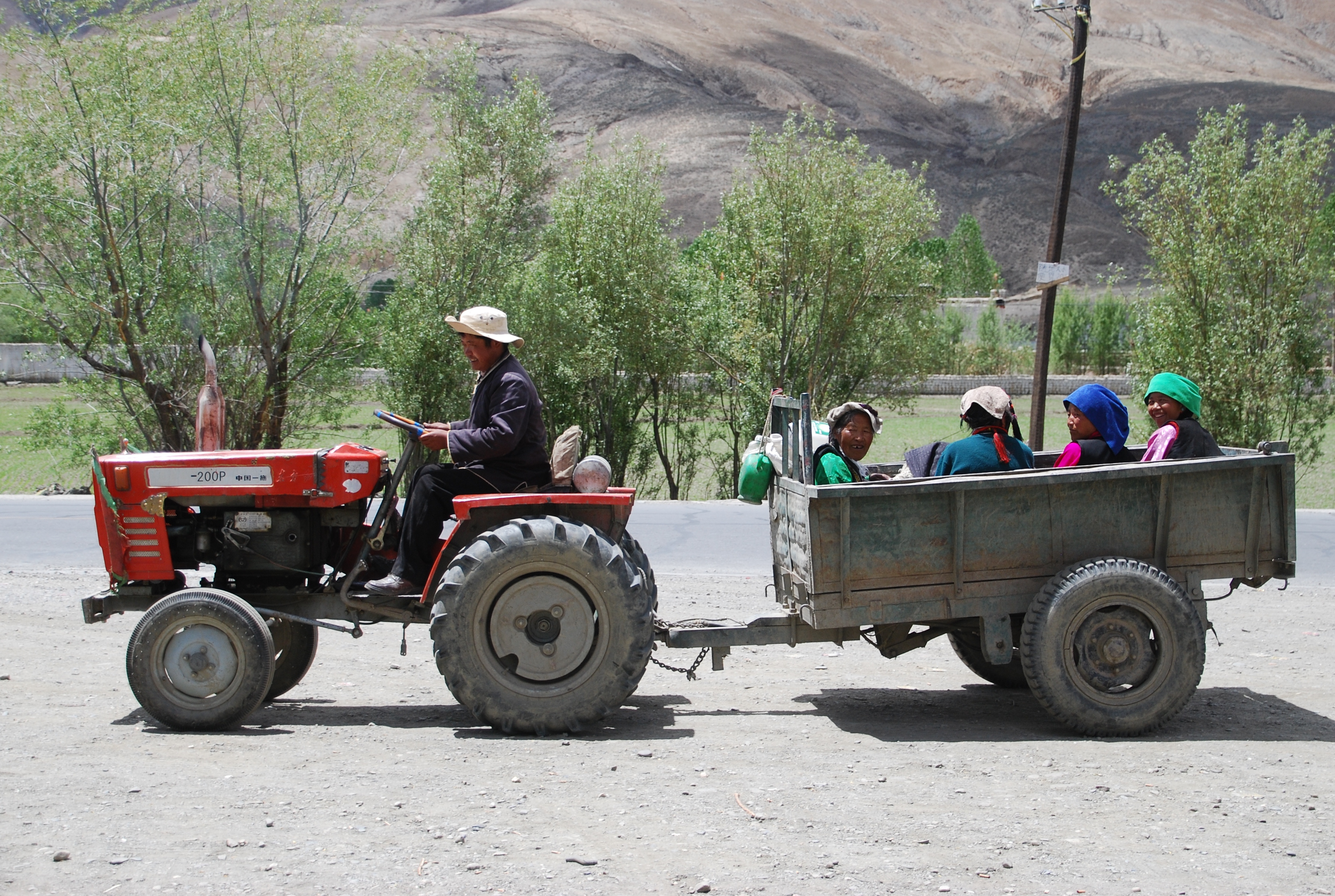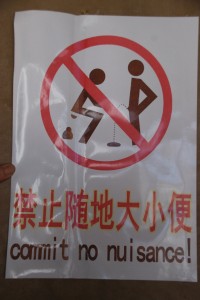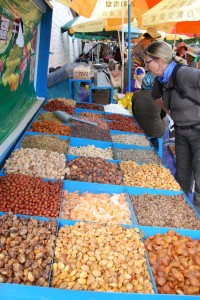Westward ho
We ducked our heads to fit through yet another very low doorway to see yet another ancient chapel when I miscalculated and banged my head hard on the top of the door. This brought a mix of laughter and sympathy from the gaggle of old women that were watching Julie and I pass by. Their heavily creased dark faces, well worn traditional hats and skirts, swinging prayer wheels and excessive jewellery marked them for what they were – hard working and deeply religious with the personality of a true Tibetan.
We were in the Pelkor Chode Monastery in the centre of old Gyantse, enjoying the early morning cool air and a climb up the Gyantse Kumbum, the largest chorten in Tibet. This chorten, or stupa or chedi or zeti or whatever you prefer, dates from the 15th century and was colourfully painted to reflect its Buddhist importance. Having eventually made the top, we took in fine views of the rest of the monastery, the dzong on the top of the hill and the rest of Old Gyantse.
Prior to climbing the chorten we went in the temple itself and as a rare treat were able to take photos (after paying 20 Yuan). This was a special place, the seat of religious power for the region for centuries, decorated with the usual statues of various Buddhas and protectors, yak butter candles burning everywhere, side chapels full of ancient manuscripts, pilgrims chanting their prayers while dozens of monks sang and chanted in the centre area. A great way to start the day.
From there we made our way up the steep uneven stone slopes to the Gyantse Dzong, not an easy feat at 4,000 metres. The dzong is no longer used for anything purposeful but we were able to wander through a couple of old rooms and the temple before getting helicopter views of the city and the monastery. We love dzongs, even if the walks up to them test us.
The drive from Gyantse westward to the next major town of Shigatse is only 90 kms but it is slowed down by the frequent photo stops through this lush farmland (yaks pulling plows always gets us) and the stupid speed control system where you are given a slip of paper with your allotted time for arriving at the next station. If you get there too early – which means you’ve missed the obvious trick to pull over on the side of the road and wait until your allotted time (which we had to do a number of times, including once for 27 minutes) – then you get a speeding ticket.
Our driver Pemba’s sister-in-law lives on a traditional farm along the way and we were given the rare invitation into their home for a yak butter tea. Like all the houses in the valley, this one was behind walls plastered with hundreds of yak dung patties drying in the sun (more photo stops). There were a few horses, cows and goats in the enclosed stable but we were ushered upstairs into their family living area for yet another endless refill of yak butter tea. White in colour and slightly thick, very salty and a little rancid on the nose, this is the staple drink of all self-respecting Tibetans and we sat in their modestly furnished home desperately trying to avoid another top up.
Shigatse is Tibet’s second largest city with 80,000 people, caught in a dusty and sandy valley with constant winds and endless construction, another nice Tibetan town feeling a bit run over by the Chinese. After a good lunch we headed for the Summer Palace of the Panchen Lama, the second highest ranking Lama.
The whole story of the current and past Panchen Lamas is a bit detailed but suffice to say Tibet’s choice of Panchen Lama is being held by the Chinese in an undisclosed location while their choice lives in Beijing and visits Tibet very rarely. His summer palace is modest and the gardens are definitely scrappy but it does have some vibrant and colourful wall paintings. One particular painting must have been a little too sexually graphic because the authorities had taped up a hankie to cover the naughty bit.
We then visited a local carpet factory and watched Tibetan carpets be made entirely by hand from local wool and dyes, quite interesting, before retiring to our hotel and a plan for a quiet night out on our own. Unfortunately our Chinese hotel, nice as it was, didn’t have power all night (or the following morning) which meant more candles in the restaurants and bedroom and no showers.
Shigatse looked a bit better the next morning and we quickly hit the huge Tashihunpo Monastery at opening time. The pilgrims were streaming in to pay their respects in the four different temples and three crypts that are part of this massive complex. The scope of this 15th century city within a monastery is vast and understandably so. It represented the power base for the Panchan Lama for a couple hundred years and is still his official monastery when he comes to Tibet.
We were a bit overwhelmed by the shoulder to shoulder pushing of the local pilgrims, all looking fantastic in their best national dress and determined beyond denial to leave their offerings of money, yak butter or barley at the dozens of temples and shrines in the complex. But the setting at the base of the rocky mountain cliff with its shimmering gold roofs and swarms of chanting monks made this a great morning spot.
Westward we continued, out of Shigatse and on to our lunch spot of Lhatse. The drive continued up through the dry brown mountain range with the only colour being the lucky red talismans on the ears of the yaks and dzos (half yak half cow) as the farmers steered them through the dusty fields. This was pretty desolate stuff, high on the plateau, no river to fortify them, harsh winds blowing through the ranges, not an easy place to live. And Lhatse, our run down town of a lunch spot, was not much better. Westerners are a real novelty here and people came into the local restaurant we were eating at to beg at our table.
But it was a day of two halves – the morning a bit flat, dusty and dreary, the afternoon a long steep climb through dramatic brown mountains up and over the Gyatse La Pass. The climb was different than the other passes we’ve conquered which have endless steep switchbacks and imposing aerial hairpin turns. This climb was steep and steady up a canyon that opened up as we gained elevation. And gain we did, up and up, past snow patches, past herds of yaks and long hair goats, past the last sign of life until we topped out at an incredible 5,248 metres – higher than the Tibet Everest Base Camp itself!
As Julie an I walked amongst the zillion prayer flags and admired the stark brown mountains around us I couldn’t help compare this to my experiences in Nepal last year when we trekked under harsh conditions for nine days to reach this level and here we are stepping out of our car to take in the cool breeze. Very surreal and I have to say I felt I was cheating a bit.
With hardly a snow patch in sight and ‘locals’ trying to sell us cheap souvenirs we pinched ourselves for our good fortune at being able to stand here in this remote corner of the world and then hopped into our Land Cruiser and started the journey down.
After losing almost 1,000 metres in elevation there was a bend in the road and a break in the mountains where we could get our first glimpses of distant Mt. Everest. We pulled over and admired the splendid view of snow and glacier capped mountains in front of us – it was Julie’s first time to see Mt. Everest and quite a moment for both of us. Well, to qualify, the bottom third of Everest was blocked by mountains in the foreground, the top third was blocked by clouds but we had fantastic views of the middle third. And that’s better than nothing.
Down to around 4,200 metres and we arrived at the frontier town of Baber where we checked into our hotel-of-sorts for the night. Baber is the last community before the turnoff for Everest and must be one of the most desolate, gritty and depressing towns on earth. Even hardened truck drivers would shudder at the sound of Baber. The town hasn’t had power for a month and probably hasn’t noticed. But here we were, in a hotel with dirty sheets, no electricity (again), room temperature beer (again) and the charm of a nuclear waste site. But we called it home.



















